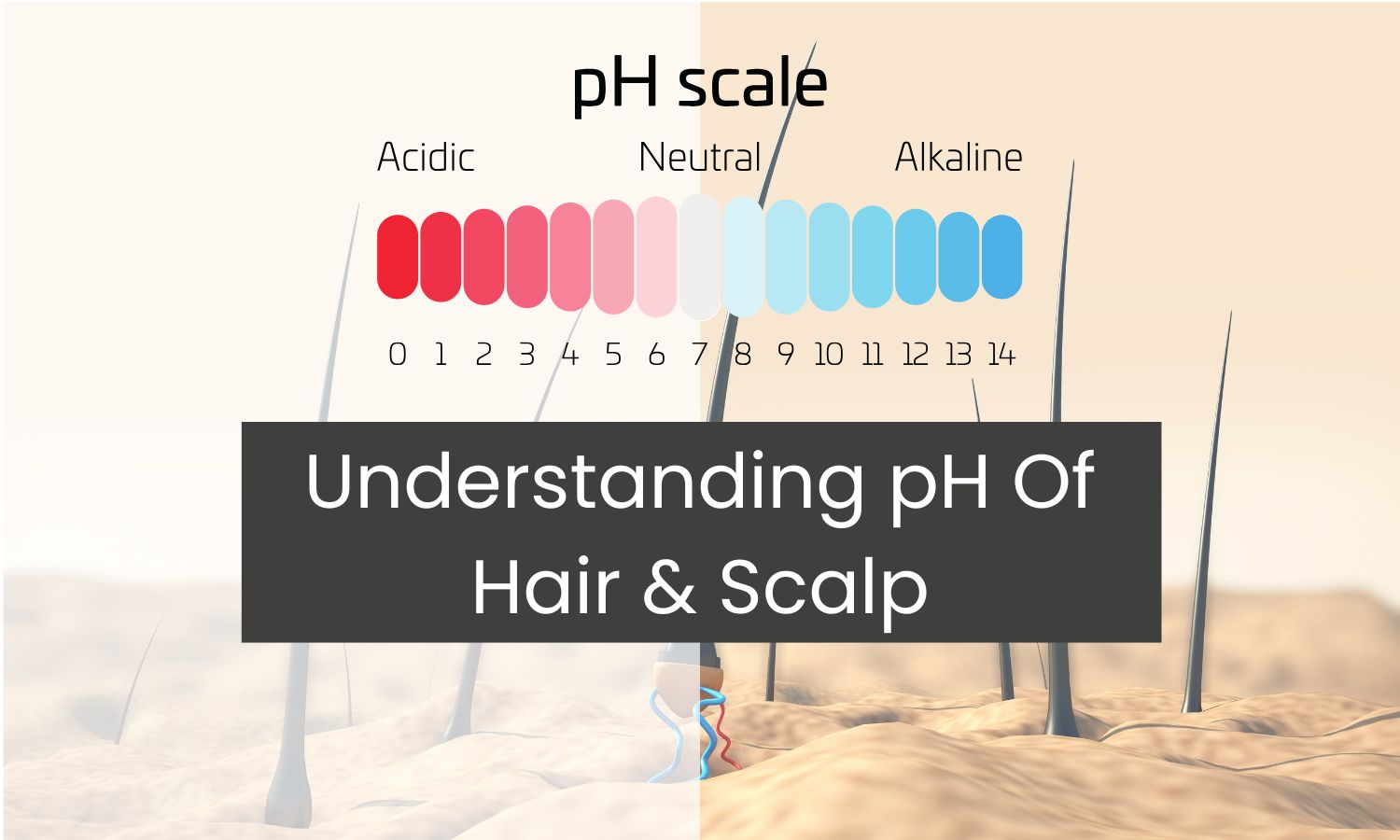What Is The pH Of Your Hair and Scalp?

When it comes to hair health, most people focus on shampoo types, conditioners, and hair oils, but there’s one silent factor that influences almost everything: pH balance.
The pH of your scalp and hair plays a vital role in maintaining their strength, shine, and resistance to damage. An imbalance can cause dryness, frizz, breakage, and even hair fall.
If you’ve ever experienced an itchy scalp after hair dye or noticed increased shedding after chemical colouring, it might be due to a pH disturbance in your scalp.
Understanding pH and Hair Health
The pH scale measures acidity or alkalinity from 0 to 14:
-
0-6: Acidic
-
7: Neutral
-
8-14: Alkaline
A healthy scalp sits between 4.5 and 5.5, slightly acidic. This natural acidity:
-
Creates a protective barrier against bacteria and fungus
-
Seals the cuticle layer of the hair
-
Locks in essential moisture and oils
Hair strands themselves have a pH of about 3.6 to 5.5, which keeps them smooth, elastic, and shiny.
How Chemical Hair Dyes Affect pH
Many chemical hair dyes have a high pH (often between 9-11) to force open the cuticles for colour penetration. While effective for colouring, this high alkalinity:
-
Strips away natural oils
-
Leaves hair cuticles permanently lifted
-
Increases scalp dryness and irritation
-
Leads to colour fading and breakage
-
Triggers an itchy scalp after hair dye or even hair fall after colouring
Frequent use of such dyes can keep the scalp in an alkaline state, making it more vulnerable to long-term damage.
The Ideal pH of Hair and Scalp
|
Area |
pH Range |
Purpose |
|
Scalp |
4.5 - 5.5 |
Maintains protective barrier, prevents irritation |
|
Hair Shaft |
3.6 - 5.5 |
Seals cuticle maintains shine and elasticity |
When pH is in balance:
-
Hair remains smooth and frizz-free
The scalp feels healthy and comfortable -
Hair colour lasts longer
-
Hair fall and breakage are reduced
Signs Your Scalp’s pH Is Imbalanced
-
Persistent itching or irritation
-
Oily scalp but dry, brittle ends
-
Frizz and dullness despite conditioning
-
Hair fall after hair dye or colouring
-
Flaky patches or redness
Tips to Maintain the pH Level of Your Scalp and Hair
Balancing pH isn’t just about one product; it’s about adopting a gentle, holistic approach. Here are some effective ways:
1. Switch to a pH-Balanced Shampoo
Avoid shampoos with harsh sulfates. Instead, choose a mild pH-neutral herbal shampoo that maintains acidity while cleansing.
2. Use a Nourishing Conditioner
A conditioner helps close the cuticle layer after washing, locking in moisture. Look for plant-oil-enriched conditioners (like coconut, argan, or almond oil) that are naturally closer to the scalp’s pH.
3. Try pH-Neutral Hair Colour Alternatives
If you colour your hair often, switch to pH-neutral hair colours or botanical-based hair dyes. These work without over-alkalising the scalp, keeping cuticles healthy and reducing post-colour hair fall.
4. Include Oil Massages in Your Routine
Certain oils help keep the scalp’s pH in balance while improving blood circulation:
-
Coconut Oil - Deeply nourishing and antimicrobial
-
Almond Oil - Rich in vitamin E, great for scalp hydration
-
Argan Oil - Smoothens and seals hair cuticles
5. Use Natural Acidic Rinses
Homemade rinses are a simple way to restore acidity:
-
Apple Cider Vinegar Rinse: 1 tbsp ACV in 1 cup water after shampooing
-
Hibiscus Flower Rinse: Soak hibiscus petals in warm water and use as a final rinse for shine
6. Home Remedies for pH Balance
-
Aloe Vera Gel: Apply fresh gel to the scalp, leave for 20 minutes, then rinse
-
Yogurt Mask: The lactic acid in yogurt gently rebalances scalp pH
-
Diluted Lemon Water: Helps lower pH instantly and refreshes the scalp
Why Maintaining pH Matters for Colour-Treated Hair
For those who colour their hair, maintaining scalp pH is even more important. Chemical dyes tend to push the scalp into an alkaline state, weakening the protective barrier. Switching to low-pH or pH-neutral colouring options can help:
-
Preserve scalp comfort
-
Reduce colour-related hair fall
-
Maintain shine and softness for longer
FAQs
Q1: What is the normal pH of the scalp?
The healthy range is 4.5 to 5.5, which is slightly acidic.
Q2: Can a pH imbalance lead to hair fall?
Yes, it can weaken the cuticle and make hair more prone to breakage.
Q3: How can I restore scalp pH naturally?
Use pH-balanced shampoos, acidic rinses like ACV, and nourishing oils.
Q4: Are there safe colouring options for sensitive scalps?
Yes, pH-neutral and botanical-based hair colours are gentler on the scalp.
Q5: How often should I check my scalp’s pH?
If you experience irritation or dryness, consider testing with skin pH strips.
Final Thoughts
The pH of your hair and scalp is a small detail with a big impact on overall hair health. When it’s in balance, your scalp stays healthy, your hair feels smoother, and colour lasts longer.
By adopting simple steps like using pH-balanced shampoos, plant-oil conditioners, mild colouring products, and natural rinses, you can keep your scalp in its ideal acidic range, ensuring stronger, healthier, and shinier hair.
Also Read:-
Top 10 Hair Care Tips For a Healthy Hair Care Routine | Rosemary Oil For Hair: Benefits, Uses, and Effect | pH Neutral Hair Color vs. Traditional Hair Dyes | The Science Behind pH Hair Color: Facts and Benefits | Picking pH-Neutral Hair Color: The Gentler and Safer Alternative to Traditional Hair Dyes




